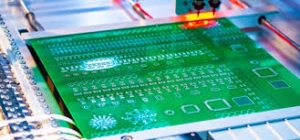FR4 is a widely used material in the manufacturing of printed circuit boards (PCBs). FR4 is a popular material for its electrical insulation and mechanical sturdiness, and is used widely in electronic applications for the very same reason. With future technological advancements, however, attention is beginning to turn towards other materials with their individual attractive traits. In this blog, we will find out how FR4 fairs as compared to these alternatives by making an in-depth comparison with factual specifics.
Electrical Performance
Dielectric Properties: FR4 has a dielectric constant (Dk) of 4.5 at 1 MHz, which is quite high as compared with its competitor materials like Rogers 4350 with Dk of 3.48. That makes Rogers material a better choice where signal loss is critical, such as with high-frequency applications. The lower Dk is often is beneficial for signal propagation over distance, making it ideal for microwave and RF applications.
Thermal Management
Temperature Tolerance: FR4 will support up to around 130°C; this is good for general electronics, but weaker in high-temperature environments. In comparison to this, polyimide materials are capable of facing up to 250°C and that is why they are more suitable for automotive or aerospace applications which demand higher thermal stability.
Fr4 Thermal Conductivity: The thermal conductivity of FR4 is roughly 0.25 W/mK, this is relatively low. And in case of designs where heat dissipation is critical, this could be a limitation. By then manufacturing the board with metal core ( eg;aluminium) this dramatically improves thermally conductivity (1-2 W/mK) aiding in faster and more efficient heat removal.
Strength and Durability of Metals
Flexural Strength: The flexural strength of FR4 is quite high, it is generally about 40 MPa. Standard is find for most applications, but it may not work for you if you need to be able bend or flex the PCB. In such conditions, flex PCB materials, meant to bend with out cracking come as a viable various.
Moisture resistance: One of the key features to consider is the moisture resistance of an FR4 pcb, while FR4 is relatively resistant to moisture, it can still absorb moisture, which can affect its dielectric properties if exposed to moisture for an extended period. Materials such as PTFE (Teflon) are hydrophobic by nature, ensuring excellent moisture resistance and performance in humid environments.

Cost and Availability
Cost-Effectiveness: One of the biggest benefits of FR4 is its cost competitive nature. This makes it a lot more inexpensive for nearly any high-performance product, making it a perfect choice for electronic devices that are mass-produced. These materials, such as Rogers or polyimide, cost more due to the special properties discussed above.
FR4 is industrial standard: FR-4 is in the industry circles known and easily to source and manufacture. Availability is such a critical factor in choosing FR4 over other materials, particularly for products where either long lead times, or scalability are a concern.
Safety and Environmental Impact
HA! - Standard FR4 contains bromine, a flame retardant halogen. This becomes an issue for end usage in halogen-free materials because of environmental or human health regulation. While the FR4 are available in halogen-free versions of the latest generations, they may still be less green than other more naturally green alternatives.
In summary, practicable FR4 material is more than enough for a large number of applications, however there are certain peculiar cases where different materiels are required. The selection of material is highly dependent upon the specific requirements such as thermal performance, electrical properties, and no of cycles, environmental suitability, etc. Engineers and designers need to know these differences to choose the most suitable material for their PCBs.